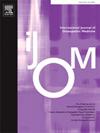腰椎间盘突出症可以通过脊柱活动恢复吗?一项单盲随机对照临床研究
IF 1.5
4区 医学
Q2 MEDICINE, GENERAL & INTERNAL
引用次数: 0
摘要
目的:本研究旨在探讨脊柱活动训练对腰椎间盘突出症(LDH)患者的突出距离、椎间盘高度、关节突关节距离以及功能状态、疼痛、活动范围(ROM)和柔韧性的影响。方法32例被试分为干预组和对照组。在研究前后通过磁共振成像评估放射学表现。在三个月前、三个月后和三个月时分别对背部表现量表、视觉模拟量表、S量表和坐伸测试进行评估。对照组接受10次稳定训练,为期5周,每周2次。结果组间分析显示,两组患者的突出距离显著减少,关节突关节距离增加,疼痛减轻,功能改善,柔韧性增强,关节活动范围延长(p <;0.05)。值得注意的是,仅在干预组观察到椎间盘高度显著增加(p <;0.05)。组间分析显示干预后各组间无显著差异(p >;0.05)。结论在LDH患者中应用活动应用可能对放射学表现、功能状态、疼痛、ROM和柔韧性有积极影响。本文章由计算机程序翻译,如有差异,请以英文原文为准。
Is regression in lumbar disk herniation possible by spinal mobilization? A single-blind randomized controlled clinical study
Aims
This study aims to examine the impacts of spinal mobilization practices on herniation distance, disc height, and facet joint distance, as well as functional status, pain, range of motion (ROM), and flexibility in lumbar disc herniation (LDH) patients.
Methods
Thirty-two participants participated in the study, divided into an Intervention and Control Group. Radiological findings were evaluated by magnetic resonance imaging before and after the study. The Back Performance Scale, Visual Analogue Scale, The S, and The Sit and Reach Test were assessed before, after, and at three months. The control group received ten sessions of stabilization exercises for five weeks, two sessions per week. In the intervention group, spinal mobilization applications were applied in addition to stabilization exercises
Results
Intra-group analysis revealed significant reductions in herniation distance, increases in facet joint distance, pain alleviation, functional improvement, enhanced flexibility, and extended ROM in both groups (p < 0.05). Notably, a significant increase in disc height was observed exclusively in the Intervention Group (p < 0.05). Inter-group analysis revealed no significant differences between the groups post-intervention (p > 0.05).
Conclusion
Mobilization applications applied in LDH patients may have a positive effect on radiological findings, functional status, pain, ROM, and flexibility.
ClinicalTrials.gov Identifier
NCT05753579 (03.02.2023)
求助全文
通过发布文献求助,成功后即可免费获取论文全文。
去求助
来源期刊
CiteScore
2.20
自引率
36.80%
发文量
42
审稿时长
3 months
期刊介绍:
The International Journal of Osteopathic Medicine is a peer-reviewed journal that provides for the publication of high quality research articles and review papers that are as broad as the many disciplines that influence and underpin the principles and practice of osteopathic medicine. Particular emphasis is given to basic science research, clinical epidemiology and health social science in relation to osteopathy and neuromusculoskeletal medicine.
The Editorial Board encourages submission of articles based on both quantitative and qualitative research designs. The Editorial Board also aims to provide a forum for discourse and debate on any aspect of osteopathy and neuromusculoskeletal medicine with the aim of critically evaluating existing practices in regard to the diagnosis, treatment and management of patients with neuromusculoskeletal disorders and somatic dysfunction. All manuscripts submitted to the IJOM are subject to a blinded review process. The categories currently available for publication include reports of original research, review papers, commentaries and articles related to clinical practice, including case reports. Further details can be found in the IJOM Instructions for Authors. Manuscripts are accepted for publication with the understanding that no substantial part has been, or will be published elsewhere.

 求助内容:
求助内容: 应助结果提醒方式:
应助结果提醒方式:


